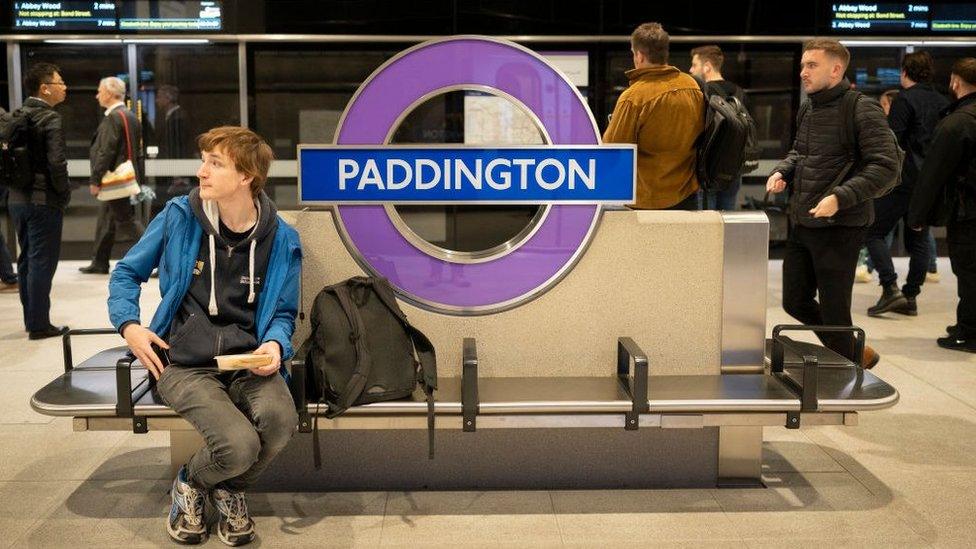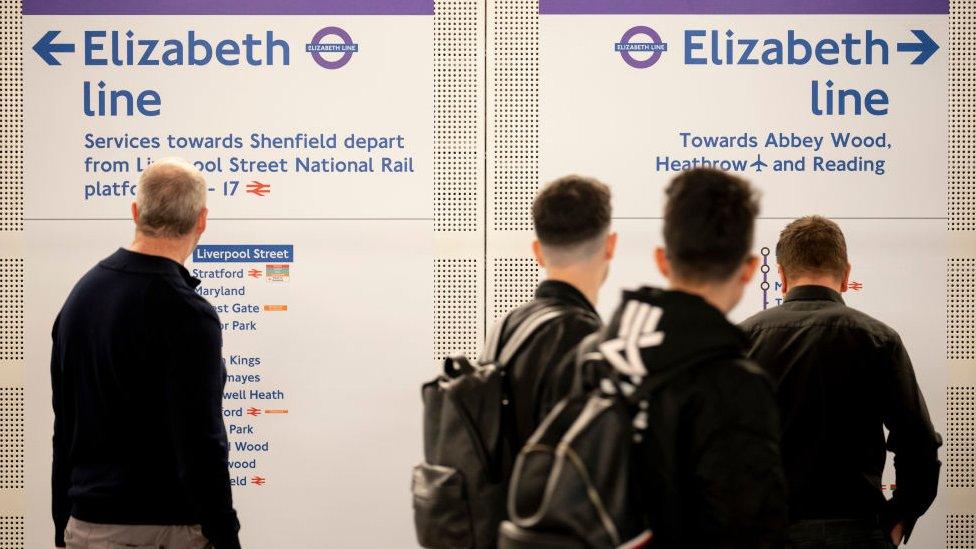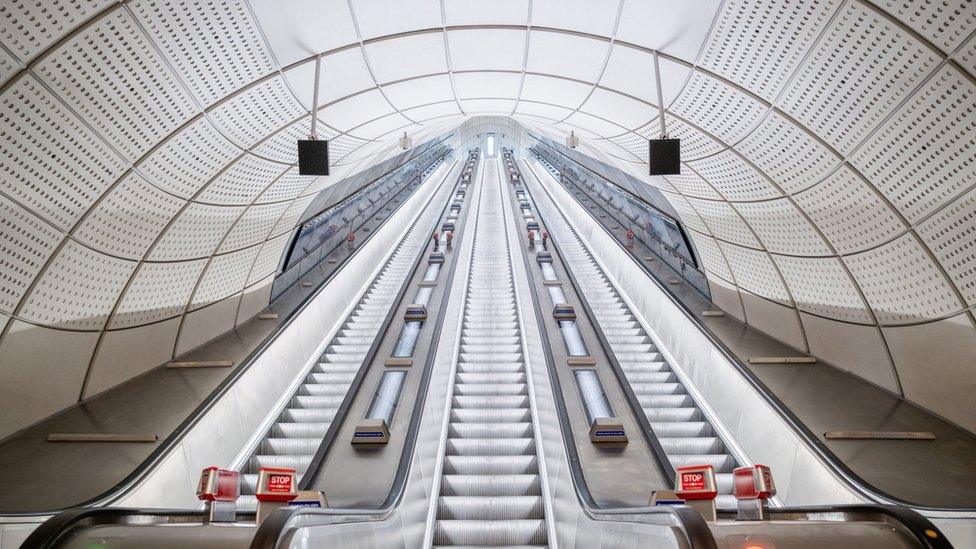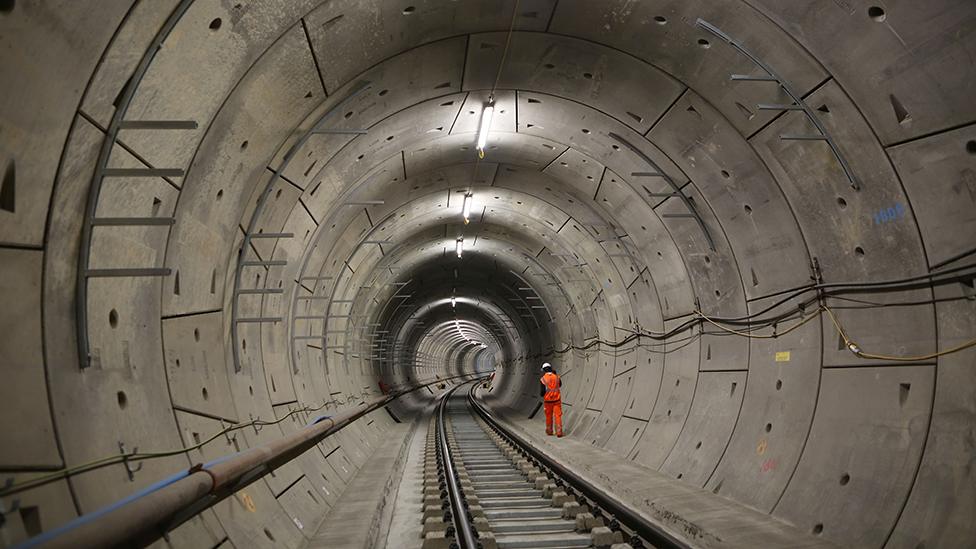Elizabeth line: What is it and when will it fully open?
- Published

Another key milestone has been reached in the development of the Crossrail project, with confirmation of the opening date for the new Bond Street station.
Three-and-a-half years late and at least £4bn over-budget, a limited service finally started in May 2022.
When fully operational, the Elizabeth line, as it is now known, will carry up to 200 million passengers each year.
What is the Elizabeth line?
One of Europe's biggest construction projects, it is a 73-mile (118km) railway, external in south-east England. It runs from the west to the east of London, tunnelling underground through central London.
There are two western branches, which terminate at Reading and Heathrow Airport, and two eastern branches, ending at Shenfield in Essex and Abbey Wood in south-east London.
Ten new stations have been built for the central London section, which connects Paddington, Bond Street, Liverpool Street and Canary Wharf.
The line is expected to increase London's train capacity by 10%.
It was first conceived in the 1980s, cancelled in the 1990s and finally approved in the 2000s. Work began in 2009, and 10,000 workers have been employed on the 13-year project.

Services can carry up to 1,500 passengers each - significantly more than a London Underground train.
The line travels across the overland rail network, while the central section runs through tunnels and connects with Tube and other rail services.
Full details of the route can be found on the Crossrail website., external
How much of the line is open?
The first train left Abbey Wood for Paddington on 24 May 2022.
More than a million journeys were made on the line in the first five days, and more than 45 million have been made so far, according to Transport for London (TfL).
However, a full service is still not operational.

At the moment, trains run Monday to Saturday every five minutes from 05:30 to 23:00 BST across three sections:
Abbey Wood to Paddington
Heathrow and Reading to Paddington
Shenfield to Liverpool Street
Services between Liverpool Street and Shenfield, and Paddington to Heathrow and Reading operate on Sundays.
When will the new Bond Street station open?
The new step-free station will begin taking passengers on 24 October, according to TfL.
Train services will initially run every five minutes, and the station will be able to accommodate nearly 140,000 people a day.

The station will have step-free access
There will be no service on Sunday 30 October. But from Sunday 6 November, trains will run every three to four minutes, seven days a week.
New connections in the central tunnels mean that, from that date, passengers will be able to:
travel from Heathrow and Reading to Abbey Wood, without having to change at Paddington
travel between Shenfield and Paddington without having to change at Liverpool Street. Passengers requiring onward journeys towards Reading and Heathrow will be able to change on the same platform at Whitechapel
travel seven days a week across the whole network, as the central section's Sunday service begins
An increased timetable between Paddington and Whitechapel will also start on 6 November. This will see up to 22 trains running per hour at peak times, rather than the current 12.
When will the service be complete?
The final timetable is due to come into effect no later than May 2023. This will see the number of services running on the central section of the line between Paddington and Whitechapel increase to 24 per hour in peak times.
At this point, direct services will be also introduced between Shenfield and Heathrow Airport.


How long will journeys take?
The new line slashes journey times for many travellers:
Abbey Wood to Paddington will be almost halved to 28 minutes
Farringdon to Canary Wharf will drop from 24 minutes to 10 minutes
Liverpool Street to Paddington will be cut from 18 to 10 minutes
Liverpool Street to Woolwich will be halved to 15 minutes
What do fares cost?
Elizabeth line fares are identical to those on the London Underground., external The cost of services previously operated under "TfL Rail" have not changed, but there is a £7.20 premium on journeys to and from Heathrow airport.
Peak single journeys to Heathrow from central London (weekdays between 06:30-09:30 and 16:00-19:00) will cost £12.70 and be £2 cheaper at other times.
In comparison, peak and off-peak Tube fares are currently £5.50 and £3.50 respectively, while the Heathrow Express costs £25.

The Queen officially opened the Elizabeth line on 24 May
Contactless pay-as-you-go payments are accepted across the line, and daily and weekly capping also applies.
Customers using pay-as-you-go Oyster cards who wish to travel to or from stations beyond West Drayton must use contactless instead, or buy a paper ticket.
Older people's Freedom Passes are accepted for free travel - including to Heathrow and Reading - after 09:00 every day.
Those with a disabled Freedom Pass can travel for free at any time.
Railcards attached to Oyster cards receive one-third off fares.
As with London Overground, folding bicycles are allowed at all times. Non-folding bikes are only allowed off-peak.
Why has it taken so long?
The chief executive of Crossrail previously admitted that the project's complexity was "off the scale", and that integrating multiple signalling systems and new software posed huge challenges.
The public spending watchdog, the National Audit Office, accused Crossrail bosses of clinging to an unrealistic opening date of December 2018.

Construction took longer than expected and went over budget
How much has it cost?
The final cost of Crossrail is estimated to be £19bn, which is more than twice the price of hosting the Olympic Games.
It was originally budgeted at £14.8bn but ballooning costs - including lost revenue from three-and-a-half years without fares and paying the salary of drivers, external - drove up the overall total.